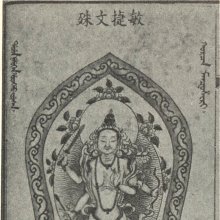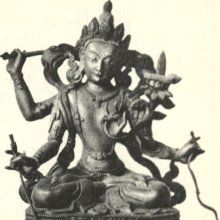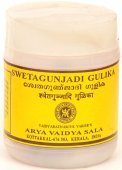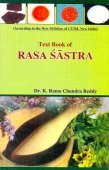Tikshna, Tīkṣṇā, Tīkṣṇa: 34 definitions
Introduction:
Tikshna means something in Buddhism, Pali, Hinduism, Sanskrit, Marathi, Hindi, biology. If you want to know the exact meaning, history, etymology or English translation of this term then check out the descriptions on this page. Add your comment or reference to a book if you want to contribute to this summary article.
The Sanskrit terms Tīkṣṇā and Tīkṣṇa can be transliterated into English as Tiksna or Tikshna, using the IAST transliteration scheme (?).
Alternative spellings of this word include Tikshn.
Images (photo gallery)
In Hinduism
Ayurveda (science of life)
Nighantu (Synonyms and Characteristics of Drugs and technical terms)
Source: Wisdom Library: Raj NighantuTīkṣṇa (तीक्ष्ण, “sharp”) refers to one of the eight kinds of Vīrya (potency), representing characteristics of medicinal drugs, according to the second chapter (dharaṇyādi-varga) of the 13th-century Raj Nighantu or Rājanighaṇṭu (an Ayurvedic encyclopedia). Accordingly, “the rasa, vīrya and vipāka of the drugs should be noted (studied) carefully. [...] By vīrya [eg., Tīkṣṇa], the working capacity and potency is meant”.
Source: WorldCat: Rāj nighaṇṭu1) Tīkṣṇā (तीक्ष्णा) is another name for Kapikacchu, a medicinal plant identified with Mucuna pruriens (velvet bean or cowhage or cowitch) from the Fabaceae or “bean family” of flowering plants, according to verse 3.50-53 of the 13th-century Raj Nighantu or Rājanighaṇṭu. The third chapter (guḍūcyādi-varga) of this book contains climbers and creepers (vīrudh). Together with the names Tīkṣṇā and Kapikacchu, there are a total of twenty-six Sanskrit synonyms identified for this plant.
2) Tīkṣṇā (तीक्ष्णा) is also mentioned as a synonym for Tejovatī, a medicinal plant similar to Jyotiṣmatī Celastrus paniculatus (black oil plant or intellect tree) from the Celastraceae or “staff vine” or “bittersweet family” of flowering plants, according to verse 3.82. The Raj Nighantu reads Jyotiṣmatī and Tejovatī together while Bāpālāl identifies Tejovatī with Zanthoxylum budrunga (cape yellowwood or Indian ivy-rue) from the Rutaceae or “rue” or “citrus” family.
3) Tīkṣṇā (तीक्ष्णा) is another name for Atyamlaparṇī, an unidentified medicinal plant, according to verse 3.130-131. Vaidyaka Śabda Sindhu equates Atyamlaparṇī with Amlaloṇī (Cāṅgerī) Oxalis corniculata Linn. (also known as creeping woodsorrel or sleeping beauty) but Chopra identifies Cāṅgerī as Rumex dentatus Linn.
4) Tīkṣṇā (तीक्ष्णा) is also identified with Cavya, a medicinal plant possibly identified with Piper chaba Hunter, or “piper chilli” from the Piperaceae or “pepper” family of flowering plants, according to verse 6.41-42.— Note: According to the Bhāvaprakāśa, the fruit of Cavya [Cavikā] is said to be Gajapippalī, identified with either Scindapsus officinalis Schott, according to Chopra, Nadkarni and Roxburgh.—The sixth chapter (pippalyādi-varga) of this book enumerates ninety-five varieties of plants obtained from the market (paṇyauṣadhi). Together with the names Tīkṣṇā and Cavya, there are a total of twelve Sanskrit synonyms identified for this plant.
Toxicology (Study and Treatment of poison)
Source: Shodhganga: Kasyapa Samhita—Text on Visha ChikitsaTīkṣṇa (तीक्ष्ण) refers to one of the sixteen varieties of “rats” (Ākhu or Mūṣika), according to the Kāśyapa Saṃhitā: an ancient Sanskrit text from the Pāñcarātra tradition dealing with both Tantra and Viṣacikitsā—an important topic from Āyurveda which deals with the study of Toxicology (Viṣavidyā or Sarpavidyā).—The Kāśyapasaṃhitā seems to consider rat poison as the next powerful one, seriously affecting human beings. Kāśyapa gives antidotes for the 16 varieties of rats (e.g., Tīkṣṇa). The author follows this up with certain general instructions in tackling poisons.
Symptoms of Tīkṣṇa: Lethargy, horripilation, itching/tingling sensation in the place of bite, multiple bruises, and headache.
Treatment (Antidote) of Tīkṣṇa: Drink of Śabdikalka with eight measures of Gomūtra and ghee. Fumigation of Śabdikalka, leaves of Vakula, snake skin (slough/ ahitvak) with Haridra and Dāru Haridrā. Lepa of Nirguṇḍī sprouts with jaggery.
Unclassified Ayurveda definitions
Source: Wisdom Library: Āyurveda and botany1) Tīkṣṇa (तीक्ष्ण, “sharp”).—One of the twenty Gurvādiguṇa, or, ‘ten opposing pairs of qualities of drugs’.—Tīkṣṇa is the characteristic of a drug referring to its ‘sharpness’, while its opposing quality, Manda, refers to its ‘dullness’. It is a Sanskrit technical term from Āyurveda (Indian medicine) and used in literature such the Caraka-saṃhitā and the Suśruta-saṃhitā.
The quality of Tīkṣṇa, present in drugs and herbs, increases the Pitta (bodily humour in control of digestion and metabolism), while it aggrevates the Kapha (bodily fluids, or ‘phlegm’). It exhibits a predominant presence of the elements Fire (agni).
2) Tīkṣṇa (तीक्ष्ण) is another name for Rājasarṣapa, which is a Sanskrit word referring to Brassica nigra (black mustard), from the Brassicaceae family. Certain plant parts of Rājasarṣapa are eaten as a vegetable (śāka), according to Caraka in his Carakasaṃhitā sūtrasthāna (chapter 27), a classical Ayurvedic work. The synonym was identified in the Rājanighaṇṭu (verse 16.121), which is a 13th century medicinal thesaurus.
Source: archive.org: Vagbhata’s Ashtanga Hridaya Samhita (first 5 chapters)Tīkṣṇa (तीक्ष्ण) refers to “pungent”, which is mentioned in verse 3.19 of the Aṣṭāṅgahṛdayasaṃhitā (Sūtrasthāna) by Vāgbhaṭa.—Accordingly, “[...] Having removed the surplus phlegm by pungent [viz., tīkṣṇa] emetics and sternutatories etc., by light and rough food, (and) by gymnastics, massage, and treading [...]”.
Note: Tīkṣṇa (“pungent”), though doubtless meant to be an attribute of “vamananasyādya”—“emetics, sternutatories, etc.” and also treated like that by the commentators, has been turned into a noun (rno, “pungent substance”) and co-ordinated with what follows by the insertion of daṅ (“and”).
Source: gurumukhi.ru: Ayurveda glossary of terms1) Tīkṣṇa (तीक्ष्ण):—The property of the substance which causes sharpness and quick penetration
2) Sharpness / fast; one of the 20 gurvadi gunas; caused due activated agni; denotes physiological & pharmacological quickening of processes; instrumental for eliminative therapy; pacifies kapha & vata, increases pitta; causes irritation, burning & excretion. An attribute of Pitta.
Source: National Mission for Manuscripts: Traditional Medicine System in IndiaTīkṣṇa (तीक्ष्ण, “sharp”) and Manda (“dull”) refers to one of the ten counterpart-couples of the twenty Śārīraguṇa (or Gurvādiguṇa), which refers to the “twenty qualities of the body”—where guṇa (property) represents one of the six divisions of dravya (drugs).—Śārīraka-guṇas are twenty in number. There are ten guṇas with their opposite guṇas. [...] Manda (“dull”) has the predominant bhūta (element) of earth, water and the associated actions of “slowing/pacifying/śamana”; while Tīkṣṇa (“sharp”) has the predominant bhūta (element) of fire and is associated with the action “penetrating/purifying/śodhana”.

Āyurveda (आयुर्वेद, ayurveda) is a branch of Indian science dealing with medicine, herbalism, taxology, anatomy, surgery, alchemy and related topics. Traditional practice of Āyurveda in ancient India dates back to at least the first millenium BC. Literature is commonly written in Sanskrit using various poetic metres.
Vyakarana (Sanskrit grammar)
Source: Wikisource: A dictionary of Sanskrit grammarTīkṣṇa (तीक्ष्ण).—Utterance with a sharp tone characterizing the pronunciation of the Abhinihita kind of circumflex vowel as opposed to the utterance which is called मृदु (mṛdu) when the circumflex, called पादवृत्त (pādavṛtta), is pronounced; cf. सर्वतीक्ष्णोऽभिनिहितः प्रश्लिष्टस्तदनन्तरम्, ततो मृदुतरौ स्वारौ जात्यक्षै-प्रावुभौ स्मृतौ । ततो मृदुतरः स्वारस्तैरोव्यञ्जन उच्यते । पादवृत्तो मृदुतमस्त्वेतत्स्वारबलाबलम् (sarvatīkṣṇo'bhinihitaḥ praśliṣṭastadanantaram, tato mṛdutarau svārau jātyakṣai-prāvubhau smṛtau | tato mṛdutaraḥ svārastairovyañjana ucyate | pādavṛtto mṛdutamastvetatsvārabalābalam) Uvvata on V. Pr. I. 125.

Vyakarana (व्याकरण, vyākaraṇa) refers to Sanskrit grammar and represents one of the six additional sciences (vedanga) to be studied along with the Vedas. Vyakarana concerns itself with the rules of Sanskrit grammar and linguistic analysis in order to establish the correct context of words and sentences.
Purana and Itihasa (epic history)
Source: JatLand: List of Mahabharata people and placesTīkṣṇa (तीक्ष्ण) is a name mentioned in the Mahābhārata (cf. XIV.8.21, XIV.8) and represents one of the many proper names used for people and places. Note: The Mahābhārata (mentioning Tīkṣṇa) is a Sanskrit epic poem consisting of 100,000 ślokas (metrical verses) and is over 2000 years old.

The Purana (पुराण, purāṇas) refers to Sanskrit literature preserving ancient India’s vast cultural history, including historical legends, religious ceremonies, various arts and sciences. The eighteen mahapuranas total over 400,000 shlokas (metrical couplets) and date to at least several centuries BCE.
Arthashastra (politics and welfare)
Source: Knowledge Traditions & Practices of India: Society State and Polity: A SurveyTīkṣṇa (तीक्ष्ण, “fireband”) refers to one of the various covers of spies, forming part of a the intelligence apparatus of a state (rājya), according to the ancient Indian science of Society and Polity, as defined in Kauṭilya’s Arthaśāstra (4th century BCE).—Kauṭilya suggests mass participation in intelligence gathering through institutions such as religion. Spies could be under the guises such as tīkṣṇa.

Arthashastra (अर्थशास्त्र, arthaśāstra) literature concerns itself with the teachings (shastra) of economic prosperity (artha) statecraft, politics and military tactics. The term arthashastra refers to both the name of these scientific teachings, as well as the name of a Sanskrit work included in such literature. This book was written (3rd century BCE) by by Kautilya, who flourished in the 4th century BCE.
Jyotisha (astronomy and astrology)
Source: Wisdom Library: Brihat Samhita by Varahamihira1) Tīkṣṇa (तीक्ष्ण) refers to “sharp” (luminous horns of an eclipse), according to the Bṛhatsaṃhitā (chapter 5), an encyclopedic Sanskrit work written by Varāhamihira mainly focusing on the science of ancient Indian astronomy astronomy (Jyotiṣa).—Accordingly, “What eclipses [i.e., āvaraṇa] the moon is bigger than the moon; what eclipses the sun is smaller than the sun. Hence in semi-lunar and semi-solar eclipses, the luminous horns are respectively blunt and sharp [i.e., tīkṣṇa]. [...]”.
2) Tīkṣṇa (तीक्ष्ण) refers to one of the seven “courses of Mercury” (Budhacāra), according to the Bṛhatsaṃhitā (chapter 7).—Accordingly, “If [Mercury—Budha] should pass through the constellations of the two Bhādrapadas, of Viśākhā, of Aśvinī and of Revatī, his course is known as Tīkṣṇa. [...] When Mercury is in his Prākṛta course, there will be increase of health, of rain, of crops and there will be prosperity in the land. If he should be either in his Saṃkṣipta or Miśra course, mankind will be partly happy and partly miserable. When in his remaining four courses, Mercury brings on adversity”.

Jyotisha (ज्योतिष, jyotiṣa or jyotish) refers to ‘astronomy’ or “Vedic astrology” and represents the fifth of the six Vedangas (additional sciences to be studied along with the Vedas). Jyotisha concerns itself with the study and prediction of the movements of celestial bodies, in order to calculate the auspicious time for rituals and ceremonies.
Shaktism (Shakta philosophy)
Source: Google Books: ManthanabhairavatantramTīkṣṇā (तीक्ष्णा) refers to one of the six Goddesses (parā-ṣaṭka) associated with Jālandhara (which is in the southern quarter), according to the Manthānabhairavatantra, a vast sprawling work that belongs to a corpus of Tantric texts concerned with the worship of the goddess Kubjikā.—[...] The six Goddesses (parā-ṣaṭka): Jālāvvā, Tīvrā, Tīkṣṇā, Caṇḍikā, Aghorā, Amarā.
Source: Brill: Śaivism and the Tantric Traditions (shaktism)Tīkṣṇa (तीक्ष्ण) refers to “sharp-natured”, according to the King Vatsarāja’s Pūjāstuti called the Kāmasiddhistuti (also Vāmakeśvarīstuti), guiding one through the worship of the Goddess Nityā.—Accordingly, “[...] I worship the three-eyed sharp-natured (tīkṣṇa) Kṣetreśa. His body is black, he has destroyed his adversaries, he carries a skull-bowl and a spear, [but] he is compassionate. I resort to Śaṅkhanidhi and Padmanidhi, who who sit upon a conch and lotus [respectively] as their seats. They are patient, bear the gestures of generosity and protection in their hands, and bring about everyone’s dreams. [...]

Shakta (शाक्त, śākta) or Shaktism (śāktism) represents a tradition of Hinduism where the Goddess (Devi) is revered and worshipped. Shakta literature includes a range of scriptures, including various Agamas and Tantras, although its roots may be traced back to the Vedas.
Shaivism (Shaiva philosophy)
Source: Brill: Śaivism and the Tantric TraditionsTīkṣṇa (तीक्ष्ण) refers to the “sharp blade (of an axe)” (which represents disattachment), according to the Vārāṇasīmāhātmya verse 1.114.—Accordingly, “The great tree of transmigration has arisen from the seed of desire. After cutting the tree with the axe of indifference, whose sharp blade is disattachment (niḥsaṅga-tīkṣṇa), they proceed on the Atimārga”.

Shaiva (शैव, śaiva) or Shaivism (śaivism) represents a tradition of Hinduism worshiping Shiva as the supreme being. Closely related to Shaktism, Shaiva literature includes a range of scriptures, including Tantras, while the root of this tradition may be traced back to the ancient Vedas.
Yoga (school of philosophy)
Source: Brill: Śaivism and the Tantric Traditions (yoga)Tīkṣṇa (तीक्ष्ण) refers to an “intense (appearance)”, according to the Amṛtasiddhi, a 12th-century text belonging to the Haṭhayoga textual tradition.—Accordingly, “The sphere of the sun is at the base of the Central Channel, complete with twelve digits, shining with its rays. The lord of creatures (Prajāpati), of intense appearance (tīkṣṇa-mūrti), travels upwards on the right. Staying in the pathways in the spaces in the channels it pervades the entire body. The sun consumes the lunar secretion, wanders in the sphere of the wind and burns up all the bodily constituents in all bodies”.

Yoga is originally considered a branch of Hindu philosophy (astika), but both ancient and modern Yoga combine the physical, mental and spiritual. Yoga teaches various physical techniques also known as āsanas (postures), used for various purposes (eg., meditation, contemplation, relaxation).
General definition (in Hinduism)
Source: Wisdom Library: HinduismTīkṣṇa (तीक्ष्ण) is a Sanskrit word roughly translating to “sharp”, “hot”, “pungent”, “fiery”, “acid” or “harsh”, “rough”, “rude” or “sharp”, “keen” etc..
In Buddhism
Mahayana (major branch of Buddhism)
Source: Wisdom Library: Maha Prajnaparamita SastraTīkṣṇa (तीक्ष्ण) refers to “sharp”, according to Mahāprajñāpāramitāśāstra (chapter 4).—Accordingly, “[...] The fetters (saṃyojana) among men (manuṣya) are light and detachment (nirvedacitta) is easy to attain (sulabha). Wisdom (prajñā) is sharp (tīkṣṇa) among the gods. This is why the Path is easily found in these two states. This is not the case in the other destinies (gati)”.
Source: academia.edu: A Study and Translation of the GaganagañjaparipṛcchāTīkṣṇa (तीक्ष्ण) refers to “acute (intellect)”, according to the Gaganagañjaparipṛcchā: the eighth chapter of the Mahāsaṃnipāta (a collection of Mahāyāna Buddhist Sūtras).—Accordingly, “Further, the so-called ‘insight (prajñā)’ is a word for calm because it is free from the flame of false discrimination; a word for the unchanging because of the purify of own character, a word for no thought-constructions because it has no basis; a word for being qua being because it is according to truth; a word for truth because it is unchanging; a word for right because it is imperishable; a word for acute intellect (tīkṣṇa-pada) because it removes bondages; a word for contentment because it has the good qualities of the noble; [...]”.
Source: De Gruyter: A Buddhist Ritual Manual on AgricultureTīkṣṇa (तीक्ष्ण) refers to “pungent (juices)” (of fruits and crops), according to the Vajratuṇḍasamayakalparāja, an ancient Buddhist ritual manual on agriculture from the 5th-century (or earlier), containing various instructions for the Sangha to provide agriculture-related services to laypeople including rain-making, weather control and crop protection.—Accordingly, [as the great Nāga kings said to the Bhagavān]: “[...] We will ripen all flowers, fruits and crops, [to be] soft-bodied, pleasing, fragrant, perfect and to have pungent (tīkṣṇa) juices. We will eliminate all discord, agitation, famine, harsh speech and bad omens. We will send down rain showers duly at the proper time. [...]”.

Mahayana (महायान, mahāyāna) is a major branch of Buddhism focusing on the path of a Bodhisattva (spiritual aspirants/ enlightened beings). Extant literature is vast and primarely composed in the Sanskrit language. There are many sūtras of which some of the earliest are the various Prajñāpāramitā sūtras.
Biology (plants and animals)
Source: Google Books: CRC World Dictionary (Regional names)1) Tikshna in India is the name of a plant defined with Acorus calamus in various botanical sources. This page contains potential references in Ayurveda, modern medicine, and other folk traditions or local practices It has the synonym Acorus calamus var. americanus (Raf.) H.D. Wulff. (among others).
2) Tikshna is also identified with Bidens pilosa It has the synonym Coreopsis leucantha L. (etc.).
3) Tikshna is also identified with Centipeda minima It has the synonym Myriogyne minuta (G. Forst.) Less. (etc.).
Example references for further research on medicinal uses or toxicity (see latin names for full list):
· Botaničeskij Žurnal (1783)
· Journal of Ethnopharmacology (1990)
· Leaves of Grass (1860)
· Index Seminum (1867)
· Adansonia (1978)
· Florulae Insularum Australium Prodromus (1786)
If you are looking for specific details regarding Tikshna, for example diet and recipes, side effects, chemical composition, pregnancy safety, extract dosage, health benefits, have a look at these references.

This sections includes definitions from the five kingdoms of living things: Animals, Plants, Fungi, Protists and Monera. It will include both the official binomial nomenclature (scientific names usually in Latin) as well as regional spellings and variants.
Languages of India and abroad
Marathi-English dictionary
Source: DDSA: The Molesworth Marathi and English Dictionarytīkṣṇa (तीक्ष्ण).—a (S) Pungent, hot, biting. 2 Vehement or fierce--fire &c. 3 fig. Keen, zealous, enthusiastic: apt, acute, intelligent: sharp, severe, sarcastic, cutting, biting.
Source: DDSA: The Aryabhusan school dictionary, Marathi-Englishtīkṣṇa (तीक्ष्ण).—a Pungent. Vehement. Fig. Zeal- ous. Sharp; cutting.
Marathi is an Indo-European language having over 70 million native speakers people in (predominantly) Maharashtra India. Marathi, like many other Indo-Aryan languages, evolved from early forms of Prakrit, which itself is a subset of Sanskrit, one of the most ancient languages of the world.
Sanskrit dictionary
Source: DDSA: The practical Sanskrit-English dictionaryTīkṣṇa (तीक्ष्ण).—a. [tij-ksna Uṇādi-sūtra 3.18.]
1) Sharp (in all senses), pungent; तीक्ष्णा नारुंतुदा बुद्धिः (tīkṣṇā nāruṃtudā buddhiḥ) Śi. 2.19.
2) Hot, warm (as rays); विवस्वता तीक्ष्णतरांशुमालिनी (vivasvatā tīkṣṇatarāṃśumālinī) Ṛtusaṃhāra 1.18.
3) Fiery, passionate.
4) Hard, forcible, strong (as upāya); आश्रयो धार्तराष्ट्राणां मानी तीक्ष्णपराक्रमः (āśrayo dhārtarāṣṭrāṇāṃ mānī tīkṣṇaparākramaḥ) Mahābhārata (Bombay) 12.1.2.
5) Rude, cross.
6) Severe, harsh, rough, strict; तीक्ष्ण- श्चैव मृदुश्च स्यात्कार्यं वीक्ष्य महीपतिः (tīkṣṇa- ścaiva mṛduśca syātkāryaṃ vīkṣya mahīpatiḥ) Manusmṛti 7.14.
7) Injurious, inauspicious.
8) Keen.
9) Intelligent, clever.
1) Zealous, vehement, energetic.
11) Devoted, self-abandoning.
12) Unfriendly, unfavourable.
13) Devout, ascetic, pious.
-kṣṇaḥ 1 Nitre.
2) Long pepper.
3) Black pepper.
3) Black mustard.
-kṣṇam 1 Iron.
2) Steel.
3) Heat, pungency.
4) War, battle.
5) Poison.
6) Death.
7) A weapon.
8) Sea-salt.
9) Haste.
1) Anything sharp (as words &c.).
11) Plague, pestilence.
Source: Cologne Digital Sanskrit Dictionaries: Edgerton Buddhist Hybrid Sanskrit DictionaryTikṣṇa (तिक्ष्ण).—[, Lefm., Tikṣu, Foucaux with v.l., wrong readings for Tiṣya, q.v. (Tibetan ḥod ldan) at Lalitavistara 172.3. Calcutta (see LV.) reads Vikṣu.]
--- OR ---
Tīkṣṇa (तीक्ष्ण).—name of a nāga: Mahāvyutpatti 3314.
Source: Cologne Digital Sanskrit Dictionaries: Shabda-Sagara Sanskrit-English DictionaryTīkṣṇa (तीक्ष्ण).—mfn.
(-kṣṇaḥ-kṣṇā-kṣṇaṃ) 1. Hot, warm. 2. Hot, pungent. 3. Self-devoted, self-abandoning, committing suicide, &c. 4. Zealous, active, warm. 5. Keen, intelligent. 6. Devout, ascetic, a devotee, a zealot. 7. Sharp, (as a sword.) n.
(-kṣṇaṃ) 1. Heat, warmth. 2. Poison. 3. Iron. 4. War, battle. 5. Plague, pestilence, epidemic, destruction. 6. Death, dying. 7. Any weapon. 8. Haste, hurry. 9. Sea salt. 10. The scrotum or testicles. 11. Any metal. 12. Pungency, the heat of pepper, &c. m.
(-kṣṇaḥ) Nitre. f.
(-kṣṇā) 1. Orris root. 2. The cast skin of a snake. E. tij to sharpen or be sharp, Unadi affix ksna .
Source: Cologne Digital Sanskrit Dictionaries: Benfey Sanskrit-English DictionaryTīkṣṇa (तीक्ष्ण).—i. e. tij + sna, I. adj., f. ṇā, 1. Sharp, [Rāmāyaṇa] 1, 44, 22. 2. Hot, [Ṛtusaṃhāra] 1, 18; flashing, [Rāmāyaṇa] 5, 29, 14. 3. Energetic,
Tīkṣṇa (तीक्ष्ण).—[adjective] sharp, hot, pungent, acid; harsh, rude, noxious; eager, quick; subtle, keen, intelligent. [masculine] a man’s name; [feminine] [Name] of [several] plants; [neuter] [adverb], as subst. *iron, poison, slaughter.
Source: Cologne Digital Sanskrit Dictionaries: Monier-Williams Sanskrit-English Dictionary1) Tīkṣṇa (तीक्ष्ण):—mf(ā)n. (√tij) sharp, hot, pungent, fiery, acid, [Ṛg-veda x, 87, 9; Atharva-veda] etc.
2) harsh, rough, rude, [Manu-smṛti vii, 140; Mahābhārata; Rāmāyaṇa; Varāha-mihira’s Bṛhat-saṃhitā]
3) sharp, keen, [Śiśupāla-vadha ii, 109; Pāṇini 5-2, 76; Kāśikā-vṛtti]
4) zealous, vehement, [cf. Lexicographers, esp. such as amarasiṃha, halāyudha, hemacandra, etc.]
5) self-abandoning, [cf. Lexicographers, esp. such as amarasiṃha, halāyudha, hemacandra, etc.]
6) (with gati, ‘a planet’s course’, or nakṣatra ‘asterism’) inauspicious, [Varāha-mihira’s Bṛhat-saṃhitā vii, 8 and 10]
7) [iic, 7](asterisms Mūla, Ārdrā, Jyeṣṭhā, Ā-śleṣā)
8) m. nitre, [cf. Lexicographers, esp. such as amarasiṃha, halāyudha, hemacandra, etc.]
9) = -taṇḍulā, [Nighaṇṭuprakāśa]
10) black pepper, [ib.]
11) black mustard, [ib.]
12) = -gandhaka, [ib.]
13) = -sārā, [ib.]
14) marjoram, [ib.]
15) white Kuśa or Darbha grass, [ib.]
16) the resin of Boswellia thurifera, [ib.]
17) an ascetic, [cf. Lexicographers, esp. such as amarasiṃha, halāyudha, hemacandra, etc.]
18) ([gana] aśvādi) Name of a man, [Rājataraṅgiṇī viii, 1742 f.]
19) of a Nāga, [Buddhist literature; cf. Lexicographers, esp. such as amarasiṃha, halāyudha, hemacandra, etc.]
20) n. [plural] sharp language, [Rāmāyaṇa ii, 35, 33; Mārkaṇḍeya-purāṇa xxxiv, 46]
21) sg. steel (cf. -varman), [Nighaṇṭuprakāśa]
22) iron, [cf. Lexicographers, esp. such as amarasiṃha, halāyudha, hemacandra, etc.]
23) any weapon, [cf. Lexicographers, esp. such as amarasiṃha, halāyudha, hemacandra, etc. [Scholiast or Commentator]]
24) sea-salt, [cf. Lexicographers, esp. such as amarasiṃha, halāyudha, hemacandra, etc.]
25) nitre, [cf. Lexicographers, esp. such as amarasiṃha, halāyudha, hemacandra, etc.]
26) Galmei, [Nighaṇṭuprakāśa]
27) poison, [cf. Lexicographers, esp. such as amarasiṃha, halāyudha, hemacandra, etc.]
28) Bignonia suaveolens, [cf. Lexicographers, esp. such as amarasiṃha, halāyudha, hemacandra, etc.]
29) Piper Chaba, [cf. Lexicographers, esp. such as amarasiṃha, halāyudha, hemacandra, etc.]
30) Asa foetida, [Nighaṇṭuprakāśa]
31) battle, [cf. Lexicographers, esp. such as amarasiṃha, halāyudha, hemacandra, etc.]
32) pestilence, [cf. Lexicographers, esp. such as amarasiṃha, halāyudha, hemacandra, etc.]
33) death, [cf. Lexicographers, esp. such as amarasiṃha, halāyudha, hemacandra, etc. [Scholiast or Commentator]]
34) heat, pungency, [Horace H. Wilson]
35) haste, [Horace H. Wilson]
36) Tīkṣṇā (तीक्ष्णा):—[from tīkṣṇa] f. Name of several plants (Mucuna pruritus, Cardiospermum Halicacabum, black mustard, atyamla-parṇī, mahā-jyotiṣmatī, vacā, sarpakaṅkālikā), [Nighaṇṭuprakāśa]
37) [v.s. ...] a mystical Name of the letter p, [Rāmatāpanīya-upaniṣad i, 77]
38) [v.s. ...] cf. a-, su-.
Source: Cologne Digital Sanskrit Dictionaries: Yates Sanskrit-English DictionaryTīkṣṇa (तीक्ष्ण):—(kṣṇaṃ) 1. n. Heat, pungency; poison; iron; war; plague; death; a weapon; haste; scrotum; sea salt; metal. m. Nitre. f. Orris root; the skin of a snake cast off. a. Hot, pungent, sharp, keen, zealous, self-devoted.
Source: DDSA: Paia-sadda-mahannavo; a comprehensive Prakrit Hindi dictionary (S)Tīkṣṇa (तीक्ष्ण) in the Sanskrit language is related to the Prakrit words: Tikkha, Tikkhāla.
[Sanskrit to German]
Sanskrit, also spelled संस्कृतम् (saṃskṛtam), is an ancient language of India commonly seen as the grandmother of the Indo-European language family (even English!). Closely allied with Prakrit and Pali, Sanskrit is more exhaustive in both grammar and terms and has the most extensive collection of literature in the world, greatly surpassing its sister-languages Greek and Latin.
Hindi dictionary
Source: DDSA: A practical Hindi-English dictionaryTīkṣṇa (तीक्ष्ण) [Also spelled tikshn]:—(a) sharp; keen; pungent; intelligent; penetrating; ~[dṛṣṭi] (endowed with) keen/penetrating vision; of keen obser vation; ~[buddhi] nimble-witted, keenly intelligent; keen intelligence.
...
Kannada-English dictionary
Source: Alar: Kannada-English corpusTīkṣṇa (ತೀಕ್ಷ್ಣ):—
1) [adjective] having a sharp edge or point; that can cut well; sharp; keen; fine edged; incisive.
2) [adjective] having or giving off heat; having a high temperature; hot.
3) [adjective] severe a) harsh; unnecessarily extreme; b) serious or stern in manner or appearance; c) grave; critical.
4) [adjective] sharply affecting the organs of taste or smell, as if by a penetrating power; biting; acrid; pungent.
5) [adjective] vigorous; energetic; intense.
6) [adjective] feeling or showing keen desire; impatient or anxious to do or get; ardent; eager.
--- OR ---
Tīkṣṇa (ತೀಕ್ಷ್ಣ):—
1) [noun] = ತೀಕ್ಷ್ಣತೆ [tikshnate].
2) [noun] an instrument or device of any kind used to injure or kill; a weapon.
3) [noun] a substance with an inherent property that tends to destroy life or impair health; poison.
4) [noun] iron or steal.
5) [noun] a conflict carried on by force of arms, as between nations or between parties within a nation; a war.
Kannada is a Dravidian language (as opposed to the Indo-European language family) mainly spoken in the southwestern region of India.
See also (Relevant definitions)
Starts with (+72): Tikshnabana, Tikshnabhanga, Tikshnabuddhi, Tikshnadamshtra, Tikshnadamshtraka, Tikshnadamshtrata, Tikshnadana, Tikshnadanda, Tikshnadhara, Tikshnadharaka, Tikshnadhare, Tikshnadhuma, Tikshnadrishti, Tikshnagandha, Tikshnagandhaka, Tikshnagni, Tikshnagolisu, Tikshnagra, Tikshnagu, Tikshnahridaya.
Ends with: Atikshna, Atitikshna, Mahatikshna, Mridutikshna, Sarvatikshna, Sutikshna, Ubhayatastikshna, Vajratikshna, Vartatikshna.
Full-text (+178): Tikshnakantaka, Tikkha, Tikshnapushpa, Mahatikshna, Tikshnashuka, Tikshnakanda, Tikshnadhara, Tikshnarasa, Tikshnadamshtra, Tikshnatandula, Tikshnata, Tikshnamshu, Sutikshna, Atikshna, Sutikshnam, Tikshnavrishana, Tikshnatva, Tikshnayasa, Taikshnayana, Tikshnapatra.
Relevant text
Search found 40 books and stories containing Tikshna, Tiksna, Tīkṣṇā, Tīkṣṇa, Tikṣṇa, Ṭīkṣṇa; (plurals include: Tikshnas, Tiksnas, Tīkṣṇās, Tīkṣṇas, Tikṣṇas, Ṭīkṣṇas). You can also click to the full overview containing English textual excerpts. Below are direct links for the most relevant articles:
Kautilya Arthashastra (by R. Shamasastry)
Chapter 12 - Conducting Mining Operations and Manufacture < [Book 2 - The duties of Government Superintendents]
Chapter 13 - Superintendent of Gold in the Goldsmiths’ Office < [Book 2 - The duties of Government Superintendents]
Chapter 14 - The Duties of the State Goldsmith in the High Road < [Book 2 - The duties of Government Superintendents]
Amarakoshodghatana of Kshirasvamin (study) (by A. Yamuna Devi)
Professions, Servants and Employed persons < [Chapter 3 - Social Aspects]
Economics (3): Goods of trade < [Chapter 3 - Social Aspects]
The Practice Manual of Noble Tārā Kurukullā (by Dharmachakra Translation Committee)
List of Mahabharata people and places (by Laxman Burdak)
Rig Veda (translation and commentary) (by H. H. Wilson)
Philosophy of Charaka-samhita (by Asokan. G)
The locations, qualities, and the functions of the doṣas < [Chapter 3 - Fundamental Theories]
Twenty general physical attributes < [Chapter 2 - Fundamental Categories]
The theory of five physical substances (pañcabhūta-siddhānta) < [Chapter 3 - Fundamental Theories]
Related products





